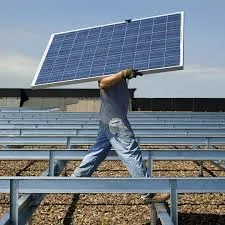Understanding the Specifications and Size of 100 Watt Solar Panels for Efficient Use
Dimensions of 100W Solar Panels An Overview
As the world shifts towards renewable energy sources, solar panels have gained immense popularity for residential and commercial use. Among them, 100W solar panels are particularly useful for applications such as small-scale energy systems, camping setups, and off-grid living. Understanding the dimensions of these panels is crucial for effective planning and installation. In this article, we will delve into the dimensions of a standard 100W solar panel, its physical characteristics, and the implications for use.
Understanding Solar Panel Ratings
Before diving into dimensions, it’s important to grasp what the wattage rating signifies. A solar panel's wattage, in this case, 100 watts, represents its power output under standard test conditions (STC). This rating assumes optimal sunlight conditions and angle, so actual performance may vary based on location, weather, and installation angle. A 100W panel is generally suitable for small devices or supplementary energy sources rather than powering larger appliances.
Typical Dimensions
100W solar panels are commonly designed to be compact and efficient, making them suitable for a variety of applications. The dimensions of 100W solar panels can vary slightly between manufacturers, but many standard panels measure approximately 47 inches (119.4 cm) in length, 21.3 inches (54 cm) in width, and around 1.4 inches (3.5 cm) in thickness.
Weight
In addition to dimensions, the weight of a 100W solar panel is another important factor to consider, particularly for installation and mounting. Typically, a 100W solar panel weighs between 15 to 20 pounds (6.8 to 9 kg). Lightweight and compact, these panels can be easily handled and installed, which is especially beneficial for those planning to set them up in remote locations or on vehicles.
Functionality and Design
dimensions of 100w solar panel

The design of a 100W solar panel usually consists of photovoltaic cells, which can be either monocrystalline or polycrystalline. Monocrystalline panels are typically more efficient and space-efficient, allowing for greater energy output in a smaller area. Conversely, polycrystalline panels are generally less expensive, making them a popular choice for budget-conscious consumers.
The physical layout of solar cells within these panels affects their overall efficiency and performance. While most panels use a fixed-grid configuration, advancements in design have allowed manufacturers to optimize the space between cells, which can enhance energy capture.
Size Considerations for Installation
When planning to install a 100W solar panel, dimensions play a critical role in ensuring that the setup fits within the intended area. Whether you are installing it on a rooftop, a recreational vehicle (RV), or a portable mounting system, accurate measurements are essential.
Applications of 100W Solar Panels
Due to their manageable size and weight, 100W solar panels are highly versatile. They can power small devices like laptops, lights, batteries, and even small refrigerators in off-grid situations. They are also widely used in conjunction with solar charge controllers and batteries for energy storage, making them an excellent choice for those living in remote areas or engaging in outdoor activities like camping.
Moreover, 100W panels can be connected in parallel or series to increase power output, thus providing flexibility for users looking to expand their solar energy systems without committing to larger panels.
Conclusion
In summary, the dimensions of a 100W solar panel are well-suited for a variety of applications, blending compactness with functionality. These panels serve as an efficient solution for those seeking renewable energy options in small spaces or remote locations. Their portability and ease of installation make them a popular choice for both beginners and experienced solar energy enthusiasts alike. By understanding the dimensions and characteristics of these solar panels, potential users can make more informed decisions about integrating solar energy into their lives. As technology continues to advance, the versatility and efficiency of solar panels will only increase, further solidifying their place in sustainable energy solutions.
-
String Solar Inverter: The High-Efficiency Solution for Smart Solar EnergyNewsJul.14,2025
-
Revolutionizing Rooftop Energy with the Power of the Micro Solar InverterNewsJul.14,2025
-
Power Independence with Smart Off Grid Solar Inverter SolutionsNewsJul.14,2025
-
On Grid Solar Inverter: Powering the Future with Smart Grid IntegrationNewsJul.14,2025
-
Monocrystalline Solar Panels: High-Efficiency Power for the Future of Clean EnergyNewsJul.14,2025
-
Bifacial Solar Panel: A Smarter Investment for Next-Generation Energy SystemsNewsJul.14,2025







